Introduction
The global jewelry market in 2018 had an estimated value of US$87 billion and is forecasted to grow to US$173 billion by 2035.
That is a lot of jewelry and much of it features diamonds. But not everyone wants or can afford natural, mined diamonds and not all jewelry manufacturers choose to use diamonds in their designs.
Visual Clues:
So how do manufacturers create pieces that give consumers the bling they want at prices they can afford? Well, they use stones that just look like diamonds. There are many different descriptors: simulants, imitations, synthetic or the most commonly used word is "fake." But each descriptor has a specific definition that we will get into later.
Simulants are not used to intentionally deceive people, they are used to resemble the look of diamonds without the associated price tags.
Although we've all heard stories of couples that go through contentious divorces, only to discover and reveal that the huge rock in their engagement ring turned out to be something else 😱 ... So if all these look alikes are not diamonds, then what exactly are they?
Before we talk specifically about diamond simulants you need to first understand what the properties of diamonds are that make them so beautiful and the properties that differentiate them from the simulants out there.
If you are looking at a diamond what do you see? It is important for you to know that even gemologists are trained to never make sight identifications of any gemstone, so we are not saying that you should either!
Definitive IDs can only be made through standard gemological tests. For the purposes of this article, I will give you a few visual clues that may be tip-offs that what you are looking at may not be a natural, earth-mined diamond.
Hardness
Gemologists define Hardness as a gem's ability to resist scratching. Hardness is measured on the non-linear Moh's scale, gem materials are ranked 1-10; diamond is ranked 10, alone at the top of the scale. Diamond is actually 140 times harder than the next lower material on the scale, e.g. sapphire, which measures 9. No gemstone or simulant rivals its surface luster.
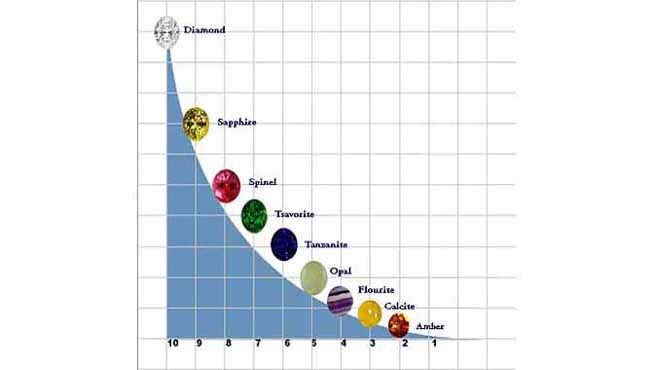
Toughness
is defined as a gem's ability to resist breaking or chipping. Both of these definitions are important when comparing diamonds to diamond simulants. What people are very surprised to hear, is that diamonds are not the toughest gem material (that would be Jade) so it's possible to chip or even break a diamond.
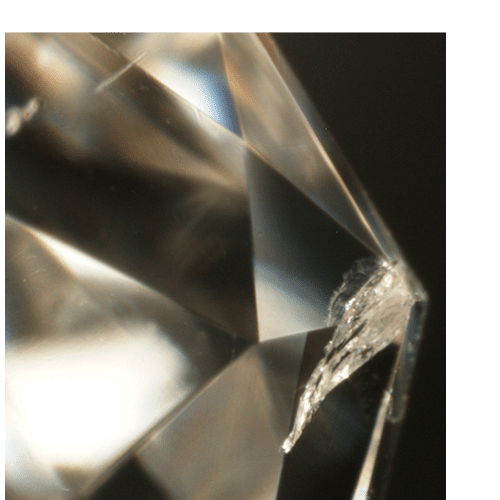
Well-cut diamonds have the ability to bend white light that enters the stone and break it up into its spectral colors as it exits, this is called dispersion, or fire.
The interesting fact is: the lower the quality diamond you are looking at, the easier it is to identify it as a natural diamond by the internal characteristics, "flaws" or inclusions that are easier to see the lower down on the GIA clarity grading scale they fall, whereas simulants are usually eye-clean, meaning you will not see any inclusions without 10x magnification.
The Most Common Diamond Look-alikes
There are two types of diamond simulants:
Gem materials that look like diamonds: e.g. Crystal quartz, white sapphires, white spinel, zircon.
Man-made imitations: Any material that has a visual likeness to diamond. E.g. glass, synthetic spinel, synthetic sapphire, and crystals (think Swarovski.)
The two most often encountered diamond look alikes are Cubic Zirconia (CZ) and Moissanite, they are considered the best of diamond imitators. But more about these later.
We will also provide a brief overview of man-made, lab-created diamonds. These are diamonds in every sense of the word except they are produced in laboratories, and retail for much more affordable prices. But first, let's look at Cubic Zirconia and Moissanite.
Cubic Zirconia (CZ)
If you conducted a survey asking people which diamond simulants they are aware of, cubic zirconia would probably be mentioned most often.
Like all simulants, CZs are transparent and near-colorless or colorless, although they are not color graded by gemological laboratories. CZs rank 8.5 on the Moh's scale, and will stand up well to everyday wear but can be scratched. These scratches or abrasions may be visible along the edges of the facets.
CZs have slightly higher levels of dispersion, or fire than diamonds, but this is difficult to discern by an untrained eye. Loose stones will feel heavier than the same size diamonds. CZs are available in a rainbow of colors.
They will also be completely colorless, whereby most diamonds have body-color, those that grade G-Z on the Gemological Institute of America's (GIA) color grading scale.
CZs are also without internal characteristics (flaws) and mined diamonds graded Flawless or Internally Flawless on the GIA scale are extremely rare.
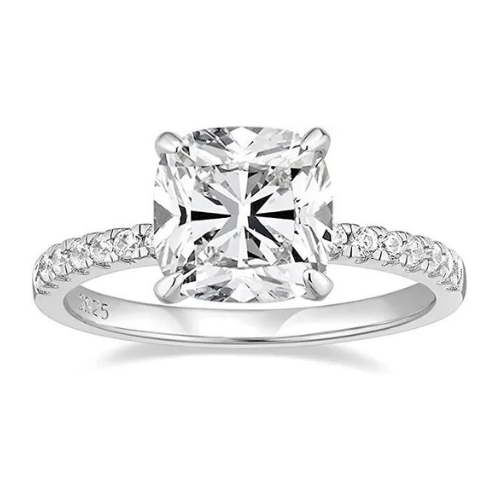
3.5 Carat Cushion Cut Cubic Zirconia Solitaire
This classic ring is crafted in sterling silver and is available in gold and rose gold tones. The center stone is an impressive 3.5 carats in weight which is surrounded by a micro-pavé half-circle of tiny cubic zirconia. Great as a promise ring or as a replacement when you do not want to wear your real diamond.
Click below to look at all the terrific options!
Synthetic Moissanite
Moissanite is a mineral that occurs very rarely in nature but is created in laboratories for commercial purposes, so its proper name is synthetic moissanite. Its hardness is close to 9 on the Moh's scale, so quite suitable for everyday wear, but will after time show scratches and abrasions. It has much higher dispersion and brilliance than diamond, which is a sure tip-off, there is too much color radiating from the stone. For this reason, they are sometimes called "disco balls"
The body color may be near colorless to slightly yellow, from D-K if graded on the GIA scale and VS, and very slightly included on the clarity grading scale, but keep in mind they are never graded in a gem lab. Although Moissanite is a good conductor of heat (but not rated excellent like diamonds) it may fool standard diamond testers; however, there are special testers available specifically for Moissanite.
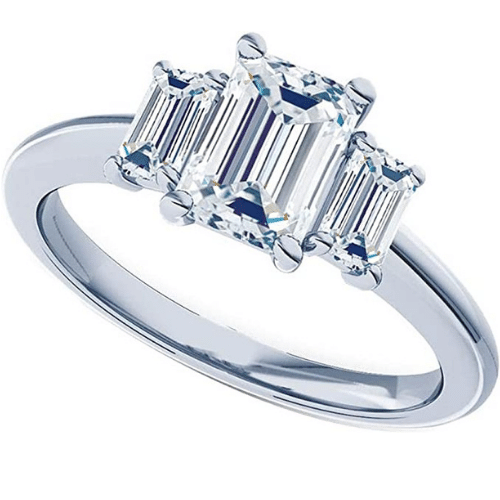
3-Stone Moissanite Ring
Moissanite, believed to be the closest in appearance to a natural diamond stars in this extraordinary 3-stone design. This stunning ring features a one-carat emerald cut center stone, flanked by two 0.50 carat emerald cuts for a total weight of two carats. Take your pick between a 10K or 14K white gold setting. This design is popular as an engagement or a right hand ring. Click below for more details.
Identification
A standard tool used by jewelers to separate diamonds from simulants is a diamond thermal tester. These instruments measure thermal conductivity. Diamond is an excellent conductor of heat; most simulants do not. The tool quickly identifies diamonds and is reliable for most simulants. CZs are poor at conducting heat.
Lab-grown Diamonds
This is the category that most confuses consumers. Man-made diamonds are produced in laboratories and feature the identical properties as natural diamonds.
Optical Properties
They look exactly the same and handle light in the same manner as their natural counterparts. That means the surface luster, brilliance, sparkle and fire will be the same, if the lab-created diamond is cut to the same angles and proportions as a natural diamond.
Physical Properties
This means they have the same weight and density.
Chemical properties
Natural diamonds are pure carbon as are lab-created diamonds.
Industrial Grade Synthetic Diamonds
Man-made diamonds have been around since scientists were first able to duplicate the process in laboratories in the 1950s. They expose pure carbon to the same heat and pressure conditions that occur more than 100 miles deep within the earth.
But these were industrial-grade diamonds, needed to fill the huge demand, for use in everything from dental drills to diamond windows in X-ray machines. They are small, heavily included, black or brown, and not at all suitable for commercial purposes.
Over the decades, processes have evolved and improved and beautiful, large man-made diamonds are found more and more in jewelry stores today; however, they must be clearly labeled and sold as such. I'm sure you have seen tons of ads from some of the largest jewelry retailers, e.g. Blue Nile, Zales, James Allen and many others.
Identification of Lab-Grown Diamonds
GIA has been grading laboratory-created diamonds since 2007. GIA laboratory-grown Diamond Reports and identification reports document the standard GIA color, clarity and cut grade of the laboratory grown diamond being graded. GIA Diamond Reports
The IGI also offers lab-grown diamond reports.
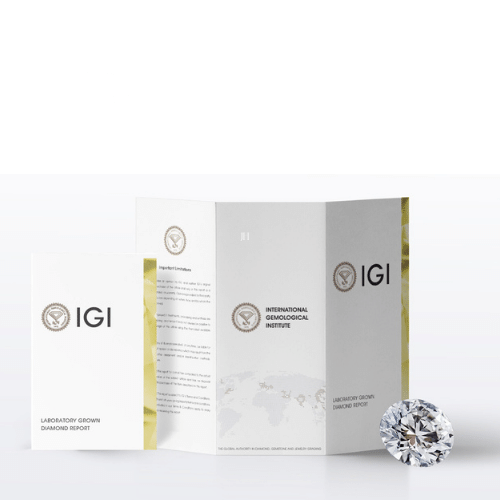
These diamonds are environmentally friendly and ethically sourced, providing peace of mind to those with concerns about these issues. In addition, the price is approximately one-third to one-half the cost of comparable mined diamonds.
As you can imagine, it is almost impossible to discern if a diamond is lab-grown or mined simply by looking at it. Even trained gemologists struggle to do so using gem microscopes. Only with advanced equipment are highly trained specialists able to rise to the challenge and definitively make the call.
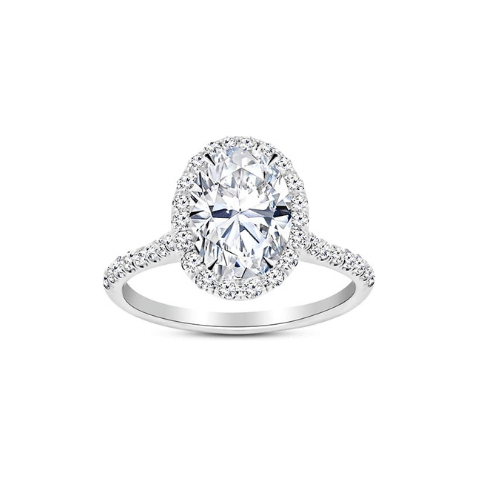
14K White Gold LAB GROWN IGI CERTIFIED DIAMOND
This classic halo style setting is 14K white features a 1.00 carat center stone and is surrounded by natural diamonds (0.75TW) in the band. The ring is available in yellow and rose gold. Accompanied by an IGI certifying that it is a lab-grown grown diamond. Because the center stone is lab-grown, it requires a gemologist with specialized equipment to distinguish it from a mined diamond. Click below for additional details.
Conclusion
How can you tell if a stone diamond or an impostor? Well, as you can see there are a few visual tip-offs when it comes to imitations. But if you have a piece of jewelry that you are unsure of, take it to a qualified jewelry appraiser and they will be able to help you.
If you are interested in learning more about man-made diamonds click Here
FAQs
How do I clean my diamond simulant or lab-grown diamond?
It is safe to clean jewelry featuring diamond simulants in the same way you clean your fine jewelry with diamonds. Use a non-abrasive jewelry cleaner, or mild hand or dish soap, warm water with a soft toothbrush. Be sure to get under the setting where is trapped. For details on keeping your jewelry beautiful read our article: The Best Jewelry Cleaning Kits.
Is it safe to size a ring with a simulant or lab-grown diamond?
Only precious metals, gold and sterling silver rings can be sized. Be sure to share with your jeweler the type of stone in your ring, if you know. If not, they will test the stone and examine the setting and let you know if there are concerns. Many lower priced rings are available in a wide range of sizes.
How durable is my diamond look alike?
Diamond simulants, materials that visually resemble diamond, rank diamond far lower on the Moh's scale. Moissanite is the hardest at 9.25. So depending on how often you wear your diamond look alike, and how rough you are on your jewelry, your stone can scratch or chip more easily than a diamond.
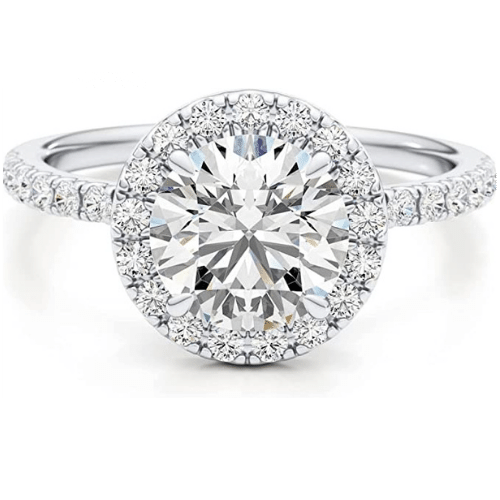
We would love to hear your thoughts and questions about simulants and lab-created diamonds. What is your preference?
Thank you for reading our article!
Francesca de Granville, G.G., F.G.A.


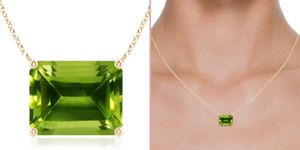
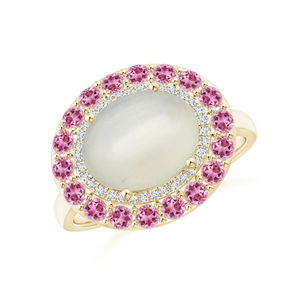
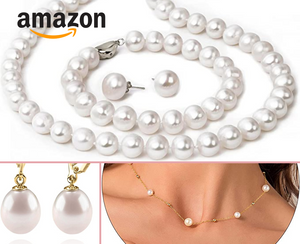
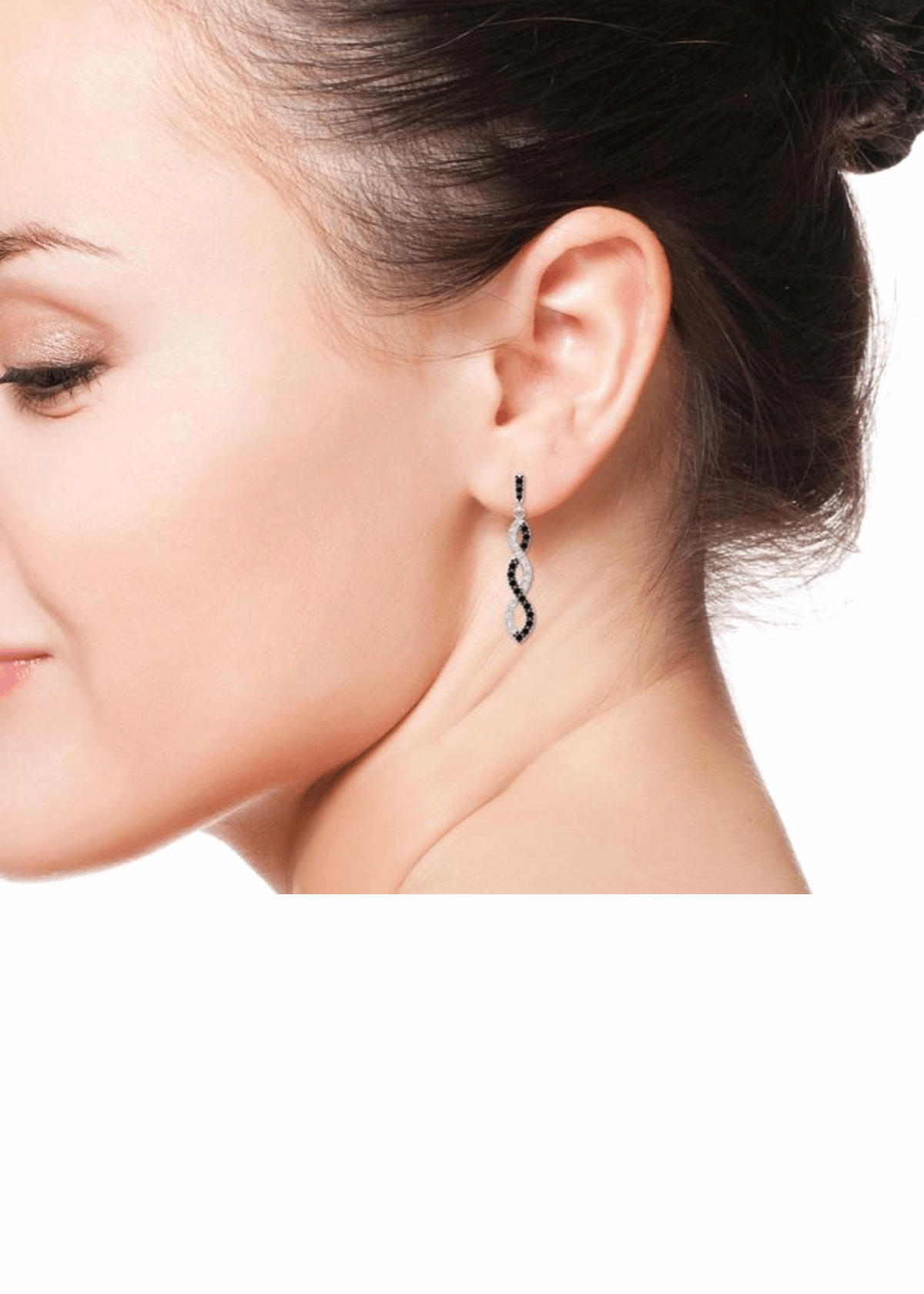
Member discussion